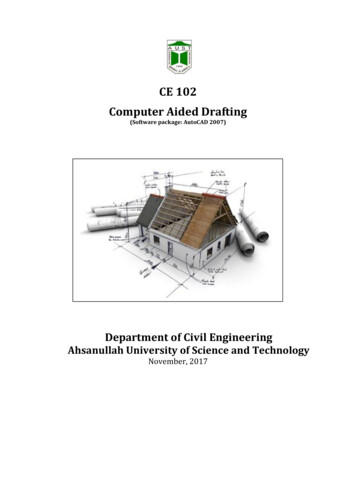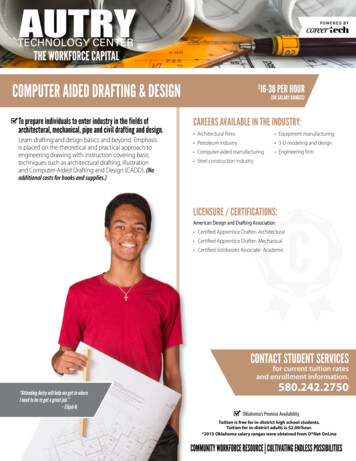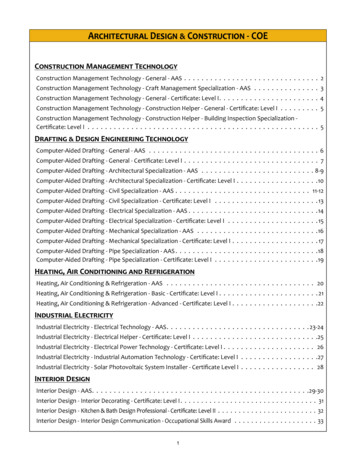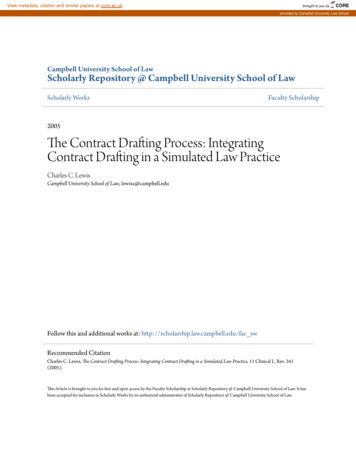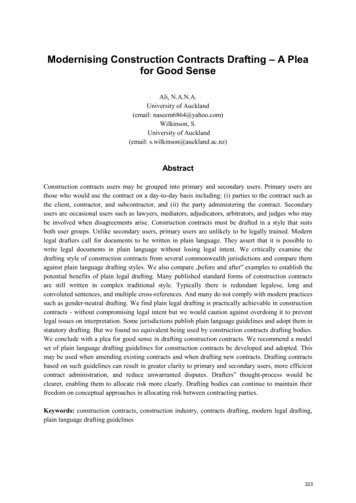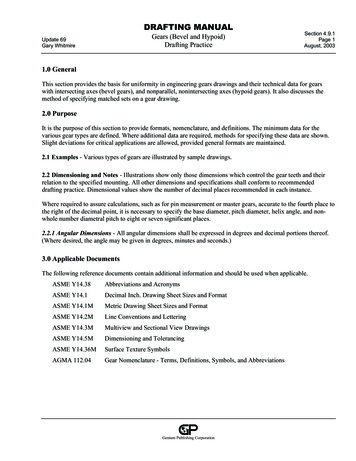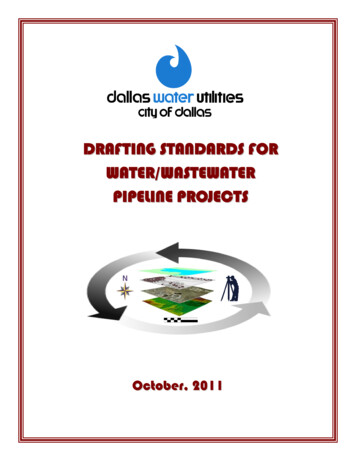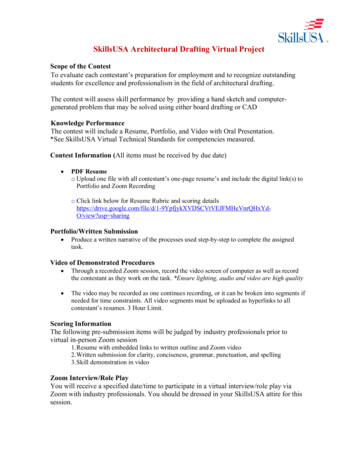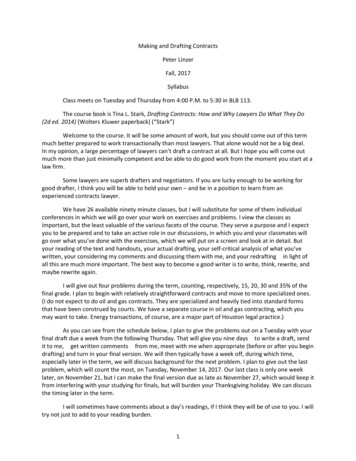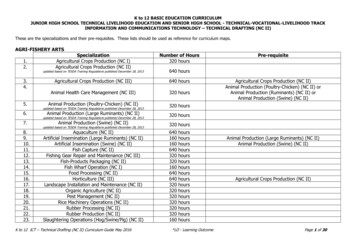
Transcription
K to 12 BASIC EDUCATION CURRICULUMJUNIOR HIGH SCHOOL TECHNICAL LIVELIHOOD EDUCATION AND SENIOR HIGH SCHOOL - TECHNICAL-VOCATIONAL-LIVELIHOOD TRACKINFORMATION AND COMMUNICATIONS TECHNOLOGY – TECHNICAL DRAFTING (NC II)These are the specializations and their pre-requisites. These lists should be used as reference for curriculum maps.AGRI-FISHERY 9.20.21.22.23.SpecializationAgricultural Crops Production (NC I)Agricultural Crops Production (NC II)Number of Hours320 hoursupdated based on TESDA Training Regulations published December 28, 2013640 hoursAgricultural Crops Production (NC III)640 hoursAnimal Health Care Management (NC III)320 hoursAnimal Production (Poultry-Chicken) (NC II)320 hoursAnimal Production (Large Ruminants) (NC II)320 hoursAnimal Production (Swine) (NC II)320 hoursupdated based on TESDA Training Regulations published December 28, 2013updated based on TESDA Training Regulations published December 28, 2013updated based on TESDA Training Regulations published December 28, 2013Aquaculture (NC II)Artificial Insemination (Large Ruminants) (NC II)Artificial Insemination (Swine) (NC II)Fish Capture (NC II)Fishing Gear Repair and Maintenance (NC III)Fish-Products Packaging (NC II)Fish Wharf Operation (NC I)Food Processing (NC II)Horticulture (NC III)Landscape Installation and Maintenance (NC II)Organic Agriculture (NC II)Pest Management (NC II)Rice Machinery Operations (NC II)Rubber Processing (NC II)Rubber Production (NC II)Slaughtering Operations (Hog/Swine/Pig) (NC II)K to 12 ICT – Technical Drafting (NC II) Curriculum Guide May rshourshourshourshourshourshours*LO - Learning OutcomePre-requisiteAgricultural Crops Production (NC II)Animal Production (Poultry-Chicken) (NC II) orAnimal Production (Ruminants) (NC II) orAnimal Production (Swine) (NC II)Animal Production (Large Ruminants) (NC II)Animal Production (Swine) (NC II)Agricultural Crops Production (NC II)Page 1 of 30
K to 12 BASIC EDUCATION CURRICULUMJUNIOR HIGH SCHOOL TECHNICAL LIVELIHOOD EDUCATION AND SENIOR HIGH SCHOOL - TECHNICAL-VOCATIONAL-LIVELIHOOD TRACKINFORMATION AND COMMUNICATIONS TECHNOLOGY – TECHNICAL DRAFTING (NC II)HOME ECONOMICSSpecializationNumber ofHours160 hours320 hours320 hours160 hours160 hours640 hours320 hours320 hours320 hours320 hours640 hours1.2.3.4.5.6.7.8.9.10.11.12.Attractions and Theme Parks Operations with Ecotourism (NC II)Barbering (NC II)Bartending (NC II)Beauty/Nail Care (NC II)Bread and Pastry Production (NC II)Caregiving (NC II)Commercial Cooking (NC III)Cookery (NC II)Dressmaking (NC II)Events Management Services (NC III)Fashion Design (Apparel) (NC III)Food and Beverage Services (NC II)13.14.15.16.17.18.19.20.Front Office Services (NC II)Hairdressing (NC II)Hairdressing (NC III)Handicraft (Basketry, Macrame) (Non-NC)Handicraft (Fashion Accessories, Paper Craft) (Non-NC)Handicraft (Needlecraft) (Non-NC)Handicraft (Woodcraft, Leathercraft) (Non-NC)Housekeeping (NC II)16032064016016016016021.22.23.24.25.Local Guiding Services (NC II)Tailoring (NC II)Tourism Promotion Services (NC II)Travel Services (NC II)Wellness Massage (NC II)160320160160160updated based on TESDA Training Regulations published December 28, 2013updated based on TESDA Training Regulations published December 28, 2013K to 12 ICT – Technical Drafting (NC II) Curriculum Guide May 2016Pre-requisiteCookery (NC II)Dressmaking (NC II) or Tailoring (NC II)160 ng (NC II)160 hourshourshourshourshourshours*LO - Learning OutcomePage 2 of 30
K to 12 BASIC EDUCATION CURRICULUMJUNIOR HIGH SCHOOL TECHNICAL LIVELIHOOD EDUCATION AND SENIOR HIGH SCHOOL - TECHNICAL-VOCATIONAL-LIVELIHOOD TRACKINFORMATION AND COMMUNICATIONS TECHNOLOGY – TECHNICAL DRAFTING (NC II)INDUSTRIAL 9.20.21.22.23.24.25.26.SpecializationNumber ofHoursAutomotive Servicing (NC I)640 hoursupdated based on TESDA Training Regulations published December 28, 2013Automotive Servicing (NC II)Carpentry (NC II)Carpentry (NC III)Construction Painting (NC II)Domestic Refrigeration and Air-conditioning (DOMRAC) Servicing (NCII)Driving (NC II)Electrical Installation and Maintenance (NC II)Electric Power Distribution Line Construction (NC II)Electronic Products Assembly and Servicing (NC II)640640320160Furniture Making (Finishing) (NC II)Instrumentation and Control Servicing (NC II)Gas Metal Arc Welding (GMAW) (NC II)Gas Tungsten Arc Welding (GTAW) (NC II)Machining (NC I)Machining (NC II)Masonry (NC II)Mechatronics Servicing (NC II)Motorcycle/Small Engine Servicing (NC II)Plumbing (NC I)Plumbing (NC II)Refrigeration and Air-Conditioning (Packaged Air-Conditioning Unit[PACU]/Commercial Refrigeration Equipment [CRE]) Servicing (NC III)Shielded Metal Arc Welding (NC I)Shielded Metal Arc Welding (NC II)Tile Setting (NC II)Transmission Line Installation and Maintenance (NC II)640320320320640640320320320320320updated based on TESDA Training Regulations published December 28, 2013K to 12 ICT – Technical Drafting (NC II) Curriculum Guide May 2016hourshourshourshoursPre-requisiteAutomotive Servicing (NC I)Carpentry (NC II)640 hours160 hours640 hours320 hoursElectrical Installation and Maintenance (NC II)640 hourshours640 hours320320320640hourshourshourshours*LO - Learning OutcomeElectronic Products Assembly and Servicing (EPAS) (NC II)Shielded Metal Arc Welding (SMAW) (NC II)Shielded Metal Arc Welding (GMAW) (NC II)Machining (NC I)Electronic Products Assembly and Servicing (EPAS) (NC II)Plumbing (NC I)Domestic Refrigeration and Air-conditioning (DOMRAC)Servicing (NC II)Shielded Metal Arc Welding (NC I)Electrical Installation and Maintenance (NC II)Page 3 of 30
K to 12 BASIC EDUCATION CURRICULUMJUNIOR HIGH SCHOOL TECHNICAL LIVELIHOOD EDUCATION AND SENIOR HIGH SCHOOL - TECHNICAL-VOCATIONAL-LIVELIHOOD TRACKINFORMATION AND COMMUNICATIONS TECHNOLOGY – TECHNICAL DRAFTING (NC II)INFORMATION, COMMUNICATIONS AND TECHNOLOGY ation (NC II)Broadband Installation (Fixed Wireless Systems) (NC II)Computer Programming (.Net Technology) (NC III)updated based on TESDA Training Regulations published December 28, 2013Number ofHours320 hours160 hours320 hoursComputer Programming (Oracle Database) (NC III)320 hoursComputer Systems Servicing (NC II)640 hoursupdated based on TESDA Training Regulations published December 28, 2013updated based on TESDA Training Regulations published December 28, 2007Contact Center Services (NC II)Illustration (NC II)Medical Transcription (NC II)Technical Drafting (NC II)Telecom OSP and Subscriber Line Installation(Copper Cable/POTS and DSL) (NC II)Telecom OSP Installation (Fiber Optic Cable) (NC II)K to 12 ICT – Technical Drafting (NC II) Curriculum Guide May 2016Computer Systems Servicing (NC II)320 hoursComputer Programming (Java) (NC III)updated based on TESDA Training Regulations published December 28, 20 hoursComputer Systems Servicing (NC II)160 hoursComputer Systems Servicing (NC II)*LO - Learning OutcomePage 4 of 30
K to 12 BASIC EDUCATION CURRICULUMJUNIOR HIGH SCHOOL TECHNICAL LIVELIHOOD EDUCATION AND SENIOR HIGH SCHOOL - TECHNICAL-VOCATIONAL-LIVELIHOOD TRACKINFORMATION AND COMMUNICATIONS TECHNOLOGY – TECHNICAL DRAFTING (NC II)Grade 7/Grade 8 (Exploratory)Course Description:This is an exploratory and introductory course that leads to a Technical Drafting National Certificate Level II (NC II). It covers five (5) common competencies thata Grade 7/Grade 8 Technology and Livelihood Education (TLE) student ought to possess, namely: 1) use of tools and equipment; 2) maintaining tools, drawinginstruments, equipment, and paraphernalia; 3) performing mensuration and calculation; 4) interpreting technical drawing and plans; and 5) practicing Occupational Healthand Safety (OHS) procedures.The preliminaries of this exploratory course include the following: 1) discussion of the relevance of the course, 2) explanation of key concepts relative to the course,and 3) exploration of career NTENT ionThe learnersThe learners shall be ableThe learners 1. Relevance of thedemonstrate anto1. Discuss the relevancecourseunderstanding ofdemonstrate commonof the course2. Basic concepts inbasic concepts andcompetencies in Technical2. Explain basic conceptsTechnical Draftingtheories in TechnicalDrafting as prescribed byin Technical Drafting3. Career opportunitiesDraftingthe TESDA Training3. Explore opportunitiesRegulationsfor a career inTechnical DraftingLESSON 1: PERSONAL ENTREPRENEURIAL COMPETENCIES (PECS)1. Assessment ofThe learnersThe learners shall be ableLO 1. Recognize PECsT.H.E IVPersonaldemonstrate antoneeded in TechnicalTLE PECS7/8-00-1Business TechnologyEntrepreneurialunderstanding ofrecognize his/her PECsDraftingBusiness Management IICompetencies andone’s PECs.and prepares an activity1.1 Assess one’s PECs:1994. pp. 6-7Skills (PECs) vis-à-visplan that aligns with thatcharacteristics,a practicingof aattributes, eneurskills, traitsein Technical Drafting1.2 Assess practitioner’s:1.1 Characteristicscharacteristics,1.2 Attributesattributes, lifestyle,1.3 Lifestyleskills, traits1.4 Skills1.3 Compare one’s PECS1.5 Traitswith those of a2. Analysis of PECs inpractitioner/relation toentrepreneura practitioner1.4 Align one’s PECS withthose of apractitioner/entrepreneurK to 12 ICT – Technical Drafting (NC II) Curriculum Guide May 2016*LO - Learning OutcomePage 5 of 30
K to 12 BASIC EDUCATION CURRICULUMJUNIOR HIGH SCHOOL TECHNICAL LIVELIHOOD EDUCATION AND SENIOR HIGH SCHOOL - TECHNICAL-VOCATIONAL-LIVELIHOOD TRACKINFORMATION AND COMMUNICATIONS TECHNOLOGY – TECHNICAL DRAFTING (NC II)PERFORMANCELEARNINGLEARNINGCONTENTCONTENT STANDARDCODESTANDARDCOMPETENCIESMATERIALSLESSON 2: ENVIRONMENT AND MARKET (EM)1. Key concepts inThe learnersThe learners shall be ableLO 1. Generate aTLE EM7/8-00-1Environmentdemonstrate anto generate a businessbusiness idea thatand Marketunderstanding ofidea based on the analysis relates with a career2. Products and servicesenvironment andof environment andchoice in Technicalavailablemarket that relate withmarket in TechnicalDraftingin the marketa career choice inDrafting1.1 Conduct SWOT3. Differentiation ofTechnical Draftinganalysisproducts and1.2 Identify the differentservicesproducts/services4. Customers and theiravailable in the marketbuying1.3 Compare differenthabitsproducts/services in5. Competition in theTechnical Draftingmarketbusiness6. SWOT Analysis1.4 Determine the profilepotential customers1.5 Determine the profilepotential competitors1.6 Generate potentialbusiness idea basedon the SWOT analysisLESSON 3: USE OF TOOLS AND EQUIPMENT (UT)1. Hand tools inThe learnersThe learners shall be ableLO 1. Prepare handTLE ICTTD7/8UT-0aCBLM ITechnical Draftingdemonstrate anto use hand tools andtools and equipment in1Technical Drawing.2. Equipment inunderstanding ofequipment in Technicaltechnical draftingModule I.Technical Draftinghand tools andDrafting1.1 List hand tools and2008. pp. 20-36.equipment in Technicalequipment based onDraftingjob requirement1.2 Identify appropriatehand tools andequipment1.3 Classify hand toolsand equipmentaccording to functionand task requirementK to 12 ICT – Technical Drafting (NC II) Curriculum Guide May 2016*LO - Learning OutcomePage 6 of 30
K to 12 BASIC EDUCATION CURRICULUMJUNIOR HIGH SCHOOL TECHNICAL LIVELIHOOD EDUCATION AND SENIOR HIGH SCHOOL - TECHNICAL-VOCATIONAL-LIVELIHOOD TRACKINFORMATION AND COMMUNICATIONS TECHNOLOGY – TECHNICAL DRAFTING (NC II)PERFORMANCELEARNINGLEARNINGCONTENTCONTENT STANDARDCODESTANDARDCOMPETENCIESMATERIALSLESSON 4: MAINTAIN HAND TOOLS, DRAWING INSTRUMENTS, EQUIPMENT AND PARAPHERNALIA (MT)1. Safety procedures inThe learnersThe learners shall be ableLO 1. Maintain handTLE ICTTD7/8MT-0bCBLM Imaintaining handdemonstrate anto maintain tools, drawing tools, drawing1Technical Drawing.tools, drawingunderstanding ofinstruments, equipment,instruments,Module IIinstruments,concepts and principlesand paraphernaliaequipment, and2008. pp. 3-4.equipment, andin maintaining handparaphernaliaparaphernaliatools, drawing1.1 Perform safety2. Proper storage ofinstruments,procedures intoolsequipment, andmaintaining hand3. Procedures inparaphernaliatools, drawingcleaning,instruments,tightening and simpleequipment, andrepair of hand tools,paraphernaliadrawing instruments,1.2 Follow procedures inequipment, andcleaning, tighteningparaphernaliaand simple repair of4. Common malfunctionhand tools, drawingwhen using handinstruments,tools, drawingequipment, andinstruments,paraphernaliaequipment, and1.3 Identify commonparaphernaliamalfunction(unplanned or unusualevents) when usingtools, drawinginstruments,equipment, andparaphernalia5. Procedures inLO 2. Inspect handTLE ICTTD7/8MT-0caccomplishing forms:tools, drawingd-25.1 Job order slipsinstruments,5.2 Requisition slipsequipment, and5.3 Borrower’s slipparaphernalia received6. Requisitionin technical draftingprocedures for handtools, drawingK to 12 ICT – Technical Drafting (NC II) Curriculum Guide May 2016*LO - Learning OutcomePage 7 of 30
K to 12 BASIC EDUCATION CURRICULUMJUNIOR HIGH SCHOOL TECHNICAL LIVELIHOOD EDUCATION AND SENIOR HIGH SCHOOL - TECHNICAL-VOCATIONAL-LIVELIHOOD TRACKINFORMATION AND COMMUNICATIONS TECHNOLOGY – TECHNICAL DRAFTING (NC II)PERFORMANCELEARNINGLEARNINGCONTENTCONTENT ts,2.1 Follow the standardequipment andprocedures inparaphernaliaaccomplishing forms7. Inspection procedures2.2 Check the list of handfor hand tools,tools, drawingdrawing instruments,instruments,equipment, andequipment, andparaphernaliaparaphernalia to berequested per jobrequirement2.3 Evaluate the conditionof all the requestedhand tools, drawinginstruments,equipment, andparaphernalia forproper operation andsafety8. Inspection report onLO 3. Prepare anTLE ICTTD7/8MT-0e8.1 Malfunctioninginspection report of the 3toolshand tools, drawing8.2 Repair of toolsinstruments,8.3 Replacement ofequipment, andtoolsparaphernalia received8.4 Lost toolsin technical drafting3.1 Follow procedures inpreparing aninspection report tothe propertycustodianLESSON 5: PERFORM MENSURATION AND CALCULATION (MC)1. Different measuringThe learnersThe learners shall be ableLO 1. Select measuringTLE ICTTD7/8MC-0fT.H.E IIIinstruments/measurindemonstrate anto perform accurateinstruments1Industrial Technology.g toolsunderstanding ofmeasurements and1.1 Identify measuringCivil Technology I.2. Appropriateconcepts and principlescalculation based on atools based on theModule I.measuringin performinggiven task.Activity I.K to 12 ICT – Technical Drafting (NC II) Curriculum Guide May 2016*LO - Learning OutcomePage 8 of 30
3.4.5.6.K to 12 BASIC EDUCATION CURRICULUMJUNIOR HIGH SCHOOL TECHNICAL LIVELIHOOD EDUCATION AND SENIOR HIGH SCHOOL - TECHNICAL-VOCATIONAL-LIVELIHOOD TRACKINFORMATION AND COMMUNICATIONS TECHNOLOGY – TECHNICAL DRAFTING (NC II)PERFORMANCELEARNINGLEARNINGCONTENTCONTENT ts for ameasurements andobject to be measured1992. pp. 5-6particular jobcalculationor job requirementsrequirements1.2 Select appropriateMeasuring differentmeasuringobjects orinstruments accordingcomponentsto job requirements3.1 Geometric shapes1.3 Interpret an object orAlternative measuringcomponent to betoolsmeasured accordingto the appropriateregular geometricshapes1.4 Use alternativemeasuring toolswithout sacrificingcost and quality ofworkTrade Mathematics/LO 2. Carry outTLE ICTTD7/8MC-0gMensurationmensuration and2Four fundamentalcalculationoperations2.1 Perform calculation6.1 Kinds ofneeded to completemeasurementtask by applying trade6.2 Dimensionsmathematics/mensura6.3 Ratio andtionproportion2.2 Employ different6.4 Trigonometrictechniques infunctionschecking for accuracy6.5 Algebraicof the computationequations6.6 Fractions,percentages,and decimals6.7 English to MetricConversion (andvice versa)K to 12 ICT – Technical Drafting (NC II) Curriculum Guide May 2016*LO - Learning OutcomePage 9 of 30
K to 12 BASIC EDUCATION CURRICULUMJUNIOR HIGH SCHOOL TECHNICAL LIVELIHOOD EDUCATION AND SENIOR HIGH SCHOOL - TECHNICAL-VOCATIONAL-LIVELIHOOD TRACKINFORMATION AND COMMUNICATIONS TECHNOLOGY – TECHNICAL DRAFTING (NC II)PERFORMANCELEARNINGLEARNINGCONTENTCONTENT STANDARDCODESTANDARDCOMPETENCIESMATERIALSLESSON 6: PREPARE AND INTERPRET TECHNICAL DRAWING (TD)1. Signs and symbolsThe learnersThe learners shall be ableLO 1. Analyze signs,TLE ICTTD7/8TD-0hused in technicaldemonstrate antosymbols, and data1drawingunderstanding ofread and interpret1.1 Identify signs and2. Technical drawingconcepts and principlestechnical drawings andsymbols used indatain interpreting technical work plans accuratelytechnical drawing2.1 Elevationdrawings and work1.2 Analyze data indicated2.2 Scaleplansin the technicalmeasurementdrawing2.3 Dimension2.4 Depth2.5 Schedule ofwindows anddoors3. Symbols of materialsLO 2. InterpretTLE ICTTD7/8MC-0i-2used in technicaltechnical drawings anddrawingplans4. Components and2.1 Identify necessaryassemblies used inmaterials according totechnical plans andthe technical drawingschematic diagram2.2 Recognize5. Basic dimensioningcomponents,and specificationsassemblies, or objectsrequirements of a planbased on jobrequirements2.3 Identify dimensionsand specificationsaccording to jobrequirementsLESSON 7: PRACTICE OCCUPATIONAL HEALTH AND SAFETY PROCEDURE (OS)1. Safety proceduresThe learnersThe learners shall be ableLO 1. Identify hazardsTLE ICTTD7/8OS-0j-1 CBLM II (part 1)2. Identification ofdemonstrate antoand risksMachining.hazards, risks andunderstanding ofconsistently observe1.1 Follow OHS policiesModule I.controlconcepts and underlying precautionary measuresand procedures in2008. pp. 2-12, 25-29.2.1 for users andprinciples ofand respond to risks andidentifying hazardstechniciansOccupational Healthhazards in the workplaceand risksK to 12 ICT – Technical Drafting (NC II) Curriculum Guide May 2016*LO - Learning OutcomePage 10 of 30
3.4.5.6.7.8.9.K to 12 BASIC EDUCATION CURRICULUMJUNIOR HIGH SCHOOL TECHNICAL LIVELIHOOD EDUCATION AND SENIOR HIGH SCHOOL - TECHNICAL-VOCATIONAL-LIVELIHOOD TRACKINFORMATION AND COMMUNICATIONS TECHNOLOGY – TECHNICAL DRAFTING (NC II)PERFORMANCELEARNINGLEARNINGCONTENTCONTENT STANDARDCODESTANDARDCOMPETENCIESMATERIALS2.2 on damagedand Safety (OHS) in1.2 Explain hazards andequipmentrelation to health andrisks in the workplace2.3 in therisk hazards in the1.3 Identify hazards andenvironmentworkplacerisks indicators asOrganizational safetyprescribed by theand health protocolmanufacturerOHS indicators1.4 Apply contingencymeasures inaccordance with theOHS proceduresSafety regulations inLO 2. Evaluate andTLE ICTTD7/8OS-0j-2 CBLM II (part 1)the workplacecontrol hazards andMachining.Methods of controllingrisksModule I.hazards and risks2.1 Determine the effects2008. pp. 13-14.Disaster preparednessof hazards in theand managementworkplace2.2 Identify the methodsin controlling hazardsand risks2.3 Follow OHSprocedures forcontrolling hazardsand risksOHS procedure,LO 3. MaintainTLE ICTTD7/8OS-0j-3 CBLM II (part 1)practices, andOccupational HealthMachining.regulationsand SafetyModule I.Emergency-related3.1 Observe established2008. pp. 47-54, 90-98.drills and trainingprocedures inresponding toemergency-relateddrill3.2 Fill-up OHS personalrecords in accordancewith SOPK to 12 ICT – Technical Drafting (NC II) Curriculum Guide May 2016*LO - Learning OutcomePage 11 of 30
K to 12 BASIC EDUCATION CURRICULUMJUNIOR HIGH SCHOOL TECHNICAL LIVELIHOOD EDUCATION AND SENIOR HIGH SCHOOL - TECHNICAL-VOCATIONAL-LIVELIHOOD TRACKINFORMATION AND COMMUNICATIONS TECHNOLOGY – TECHNICAL DRAFTING (NC II)(160 hours)Course Description:This is a specialization course that leads to a Technical Drafting National Certificate Level II (NC II). It covers five (5) core manual drafting competencies that ahigh school student ought to possess, namely: 1) architectural layout and details, 2) structural layout and details, 3) electrical and electronic layout and details, 4) sanitaryand plumbing layout and details, and 5) mechanical layout and details.The preliminaries of this specialization course include the following: 1) discussion of the relevance of the course, 2) explanation of key concepts relative to the course,and 3) exploration of career opportunities.PERFORMANCELEARNINGCONTENTCONTENT STANDARDLEARNING COMPETENCIESCODESTANDARDMATERIALSIntroductionThe learners demonstrate anThe learners shall be ableThe learners 1. Relevance of the course understanding ofto1. Discuss the relevance of2. Core concepts ofbasic concepts, theories, andcreate/provide quality andthe courseTechnical Draftingcore competencies inmarketable product and/or 2. Explain the core concepts3. Career opportunitiesTechnical Draftingservice in terms ofof Technical DraftingTechnical Drafting as3. Explore job opportunitiesprescribed by the TESDAfor a career in TechnicalTraining RegulationDraftingLESSON 1: PERSONAL ENTREPRENEURIAL COMPETENCIES (PECS)1. Assessment of Personal The learners demonstrate anThe learners shall be ableLO 1. Recognize PECsTLE PECS9-12- T.H.E IVCompetencies and Skills understanding oftoneeded in TechnicalI0-1Business Technology.(PECs) vis-à-vis aone’s PECs in Technicalrecognize his/her PECs and DraftingBusinesspracticingDraftingprepare an activity plan1.1 Assess one’s PECs:Management II.entrepreneur/that aligns with that of acharacteristics, attributes,Module I.employee inpractitioner/entrepreneurlifestyle, skills, traitsLesson I.locality/townin Technical Drafting1.2 Assess practitioner’s:1994. pp. 6-7.1.1 Characteristicscharacteristics, attributes,1.2 Attributeslifestyle, skills, traits1.3 Lifestyle1.3 Compare one’s PECs with1.4 Skillsthose of a1.5 Traitspractitioner/entrepreneur2. Analysis of PECs in1.4 Align one’s PECs withrelationthose of ato a practitionerpractitioner/entrepreneur3. Align, strengthen, anddevelop one’s PECsbased on the resultsK to 12 ICT – Technical Drafting (NC II) Curriculum Guide May 2016*LO - Learning OutcomePage 12 of 30
K to 12 BASIC EDUCATION CURRICULUMJUNIOR HIGH SCHOOL TECHNICAL LIVELIHOOD EDUCATION AND SENIOR HIGH SCHOOL - TECHNICAL-VOCATIONAL-LIVELIHOOD TRACKINFORMATION AND COMMUNICATIONS TECHNOLOGY – TECHNICAL DRAFTING (NC II)PERFORMANCELEARNINGCONTENTCONTENT STANDARDLEARNING COMPETENCIESCODESTANDARDMATERIALSLESSON 2: ENVIRONMENT AND MARKET (EM)1. Market (Town)The learners demonstrate anThe learners shall be ableLO 1. Recognize andTLE EM9-122. Key concepts of market understanding oftounderstand the market inI0-1players in the marketenvironment and market increate a business vicinityTechnical Drafting(Competitors)Technical Drafting in one’smap reflective of potential1.1 Identify the players/3. Products and serviceslocality/townTechnical Drafting marketcompetitors in the townavailable in the marketin the locality/town1.2 Identify the differentproducts/services availablein the market4. Market (Customer)5. Key concepts ofidentifying andunderstanding theconsumer6. Consumer Analysisthrough:7.1 Observation7.2 Interviews7.3 FGD7.4 SurveyLESSON 3: DRAFTING ARCHITECTURAL LAYOUT AND DETAILS (AL)1. Drafting tools, materials, The learners demonstrate anThe learners shall be ableand equipmentunderstanding ofto2. Industry Standards andconcepts and principles in the prepare architecturalOperating Procedurespreparation of architecturallayout and details based3. Architecturallayout and detailson established industry3.1 Job requirementsand/or job requirements3.2 Electrical termsand symbols3.3 Working drawingsK to 12 ICT – Technical Drafting (NC II) Curriculum Guide May 2016LO 2. Recognize thepotential customer/marketin Technical Drafting2.1 Identify the profile ofpotential customers2.2 Identify the customer’sneeds and wants throughconsumer analysis2.3 Conduct consumer/marketanalysisTLE EM9-12I0-2LO 1. Prepare architecturaljob requirements1.1 Prepare tools, materials,and equipment intechnical drawing1.2 Select drawing tools,materials, and equipmentin accordance with theSOP1.3 Assess architectural jobrequirements based onSOPTLE ICTTD912AL-Ia-1*LO - Learning OutcomeCBLM ITechnical DrawingModule I.2008. pp. 20-36.Page 13 of 30
K to 12 BASIC EDUCATION CURRICULUMJUNIOR HIGH SCHOOL TECHNICAL LIVELIHOOD EDUCATION AND SENIOR HIGH SCHOOL - TECHNICAL-VOCATIONAL-LIVELIHOOD TRACKINFORMATION AND COMMUNICATIONS TECHNOLOGY – TECHNICAL DRAFTING (NC II)PERFORMANCELEARNINGCONTENTCONTENT STANDARDLEARNING COMPETENCIESCODESTANDARDMATERIALS1.4 Interpret blueprintaccording to architecturallayout drawing/jobrequirements followingSOP and work instructions4. OHS policies andLO 2. Prepare and set upTLE ICTTD9procedurestools and materials for12AL-Ib-2lawsdrawing4.1 Personal safety2.1 Observe OHS policies and4.2 Workplace hazardsprocedures in setting-up4.3 Environment lawstools and materials for5. Setting up drawingdrawingequipment2.2 Prepare drawing tools,6. Layouting drawings andmaterials and equipmentdetailsbased on job requirements2.3 Set up tools, materials,and equipment based onthe job requirements7. Theory and concepts ofLO 3. Draft siteTLE ICTTD9site development plandevelopment plan12AL-Ic-e-37.1 Site Plans3.1 Draw a technical descrip7.2 Azimuthtion of a lot according to7.3 Coordinate planesthe approved lot survey8. Title block and borders3.2 Draw a building footprint9. Alphabet of linesaccording to the10. Letteringarchitectural drafting11. Notes and legends ofstandardsarchitectural plans and3.3 Draw a title blockstandardsaccording to the12. Layouting,architectural draftingdimensioning, andstandardsscaling3.4 Indicate dimension lines,13. Grading conventionsdimensions, and drawingand symbolstitles according toarchitectural draftingstandardsK to 12 ICT – Technical Drafting (NC II) Curriculum Guide May 2016*LO - Learning OutcomePage 14 of 30
14.15.16.17.K to 12 BASIC EDUCATION CURRICULUMJUNIOR HIGH SCHOOL TECHNICAL LIVELIHOOD EDUCATION AND SENIOR HIGH SCHOOL - TECHNICAL-VOCATIONAL-LIVELIHOOD TRACKINFORMATION AND COMMUNICATIONS TECHNOLOGY – TECHNICAL DRAFTING (NC II)PERFORMANCELEARNINGCONTENTCONTENT STANDARDLEARNING COMPETENCIESCODESTANDARDMATERIALSFloor plan featuresLO 4. Draft floor plansTLE ICTTD9T.H.E IVFloor planning scale4.1 Draw walls, windows,12AL-If-j-4IndustrialSchedule of doors anddoors, fixtures, and fittingsTechnology. Draftingwindowsaccording to architecturalII.Architectural floordesign standardsModule II.symbols4.2 Draw grid and dimensionLesson III-VIII.lines according to1993. pp. 29-84.architectural designstandards4.3 Use metric scale systemaccording to themagnitude of the plan4.4 Identify sizes of doors,walls, and rooms followingthe scheduleIndicate letterings andlabels according to thedrafting standards18. Operational definition/terminologies on roofplans19. Roof parts andmembers20. Architectural roofsymbols21. Sheet contents22. Framing detailsK to 12 ICT – Technical Drafting (NC II) Curriculum Guide May 2016LO 5. Draft roof plans5.1 Indicate the dimensions ofthe roof plan based on thefloor plan5.2 Draw roof plans accordingto drafting standards5.3 Use standard architecturalsymbols in drafting roofplans5.4 Layout drawings accordingto sheet contents5.5 Draw framing details ofroof plan according toarchitectural draftingstandards*LO - Learning OutcomeTLE ICTTD912AL-IIa-c-5T.H.E IVIndustrialTechnology. DraftingII.Module II.Lesson IV.1993. pp. 59-60.Page 15 of 30
23.24.25.26.27.28.29.K to 12 BASIC EDUCATION CURRICULUMJUNIOR HIGH SCHOOL TECHNICAL LIVELIHOOD EDUCATION AND SENIOR HIGH SCHOOL - TECHNICAL-VOCATIONAL-LIVELIHOOD TRACKINFORMATION AND COMMUNICATIONS TECHNOLOGY – TECHNICAL DRAFTING (NC II)PERFORMANCELEARNINGCONTENTCONTENT STANDARDLEARNING COMPETENCIESCODESTANDARDMATERIALSOperational definition/LO 6. Draft ceiling plansTLE ICTTD9terminology on ceiling6.1 Draw vertical heights from 12AL-IId-f-6plansfinish floor line to ceilingCeiling parts andline according to architectmemberstural drafting standardsProcedures in drafting6.2 Indicate lighting fixturesceiling plansand fire protection deviceson the ceiling plan basedon architectural draftingstandardsOperational definition/LO 7. Draft elevations andTLE ICTTD9T.H.E IVterminology ofsections12AL-IIg-i-7Industrialelevations and sections6.1 Draw vertical heights fromTechnology. DraftingArchitectural detailinggrade line according toII.and sectioningarchitectural draftingModule II.Different house viewsstandardsLesson IV.and elevations6.2 Project offsets from right,1993. pp. 47-64.Detailing techniquesleft, and rear sides offloor plan according toarchitectural draftingstandards6.3 Draw roof eaves andpitch on all elevations andsections according toarchitectural draftingstandards6.4 Project doors and windowsin all elevations andsections6.5 Project cross and longitudinal section views from thefloor plans and elevations6.6 Indicate various materialsymbols and specificationsin all elevations andsectionsK to 12 ICT – Technical Drafting (NC II) Curriculum Guide May 2016*LO - Learning OutcomePage 16 of 30
K to 12 BASIC EDUCATION CURRICULUMJUNIOR HIGH SCHOOL TECHNICAL LIVELIHOOD EDUCATION AND SENIOR HIGH SCHOOL - TECHNICAL-VOCATIONAL-LIVELIHOOD TRACKINFORMATION AND COMMUNICATIONS TECHNOLOGY – TECHNICAL DRAFTING (NC II)PERFORMANCELEARNINGCONTENTCONTENT STANDARDLEARNING COMPETENCIESCODESTANDARDMATERIALS26. Dimensions andLO 8. Submit completeTLE ICTTD9markingsdrawings12AL-IIj-827. Company rules and8.1 Follow the SOP whenregulationssubmitting the completed28. Re-work proceduresdrawing to appropriate29. Clean-up activitiespersonnel (e.g., Engineer,30. HousekeepingArchitect)8.2 Note comments andcorrections for finaldrawings following theSOP
technical drawing. module i. 2008. pp. 20-36. k to 12 basic education curriculum junior high school technical livelihood education and senior high school - technical-vocational-livel


